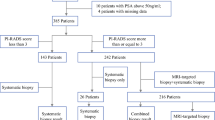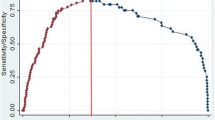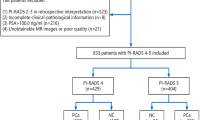Abstract
Purpose
This study was designed to investigate the effectiveness of magnetic resonance imaging (MRI) in diagnosing prostate cancer (PCa) and high-grade prostate cancer (HGPCa) before transrectal ultrasound (TRUS)-guided biopsy.
Methods
The clinical data of 894 patients who received TRUS-guided biopsy and prior MRI test from a large Chinese center was reviewed. Based on Prostate Imaging Reporting and Data System (PI-RADS) scoring, all MRIs were re-reviewed and assigned as Grade 0–2 (PI-RADS 1–2; PI-RADS 3; PI-RADS 4–5). We constructed two models both in predicting PCa and HGPCa (Gleason score ≥ 4 + 3): Model 1 with MRI and Model 2 without MRI. Other clinical factors include age, digital rectal examination, PSA, free-PSA, volume, and TRUS.
Results
PCa and HGPCa were present in 434 (48.5 %) and 218 (24.4 %) patients. An MRI Grade 0, 1, and 2 were assigned in 324 (36.2 %), 193 (21.6 %) and 377 (42.2 %) patients, which was associated with the presence of PCa (p < 0.001) and HGPCa (p < 0.001). Particularly in patients aged ≤55 years, the assignment of MRI Grade 0 was correlated with extremely low rate of PCa (1/27) and no HGPCa. The c-statistic of Model 1 and Model 2 for predicting PCa was 0.875 and 0.841 (Z = 4.2302, p < 0.001), whereas for predicting HGPCa was 0.872 and 0.850 (Z = 3.265, p = 0.001). Model 1 exhibited higher sensitivity and specificity at same cutoffs, and decision-curve analysis also suggested the favorable clinical utility of Model 1.
Conclusions
Prostate MRI before biopsy could predict the presence of PCa and HGPCa, especially in younger patients. The incorporation of MRI in nomograms could increase predictive accuracy.




Similar content being viewed by others
References
Heidenreich A, Bastian PJ, Bellmunt J, et al. EAU guidelines on prostate cancer. Part 1: screening, diagnosis, and local treatment with curative intent-update 2013. Eur Urol. 2014;65:124–37.
Schroder F, Kattan MW. The comparability of models for predicting the risk of a positive prostate biopsy with prostate-specific antigen alone: a systematic review. Eur Urol. 2008;54:274–90.
Chun FK, Briganti A, Graefen M, et al. Development and external validation of an extended 10-core biopsy nomogram. Eur Urol. 2007;52:436–44.
Jeong IG, Lim JH, Hwang SS, et al. Nomogram using transrectal ultrasound-derived information predicting the detection of high grade prostate cancer on initial biopsy. Prostate Int. 2013;1:69–75.
Kawakami S, Numao N, Okubo Y, et al. Development, validation, and head-to-head comparison of logistic regression-based nomograms and artificial neural network models predicting prostate cancer on initial extended biopsy. Eur Urol. 2008;54:601–11.
Carter HB, Albertsen PC, Barry MJ, et al. Early detection of prostate cancer: AUA Guideline. J Urol. 2013;190:419–26.
Barentsz JO, Richenberg J, Clements R, et al. ESUR prostate MR guidelines 2012. Eur Radiol. 2012;22:746–57.
Haffner J, Lemaitre L, Puech P, et al. Role of magnetic resonance imaging before initial biopsy: comparison of magnetic resonance imaging-targeted and systematic biopsy for significant prostate cancer detection. BJU Int. 2011;108:E171–8.
Park BK, Park JW, Park SY, et al. Prospective evaluation of 3-T MRI performed before initial transrectal ultrasound-guided prostate biopsy in patients with high prostate-specific antigen and no previous biopsy. AJR Am J Roentgenol. 2011;197:W876–81.
Yerram NK, Volkin D, Turkbey B, et al. Low suspicion lesions on multiparametric magnetic resonance imaging predict for the absence of high-risk prostate cancer. BJU Int. 2012;110:E783–8.
Thompson J, Lawrentschuk N, Frydenberg M, Thompson L, Stricker P. The role of magnetic resonance imaging in the diagnosis and management of prostate cancer. BJU Int. 2013;112 Suppl 2:6–20.
Jemal A, Fedewa SA, Ma J, et al. Prostate cancer incidence and PSA testing patterns in relation to USPSTF screening recommendations. JAMA. 2015;314:2054–61.
Schroder FH, Hugosson J, Roobol MJ, et al. Screening and prostate-cancer mortality in a randomized European study. N Engl J Med. 2009;360:1320–8.
Andriole GL, Crawford ED, Grubb RL 3rd, et al. Mortality results from a randomized prostate-cancer screening trial. N Engl J Med. 2009;360:1310–9.
Brawer MK, Chetner NP. Campbell’s urology. 7th edn. W.B. Saunders; 1998.
Muller BG, Shih JH, Sankineni S, et al. Prostate cancer: interobserver agreement and accuracy with the revised prostate imaging reporting and data system at multiparametric MR imaging. Radiology. 2015;277:741–50.
Harrell FE. Regression modeling strategies: with applications to linear models, logistic regression, and survival analysis. New York: Springer; 2001.
Vickers AJ, Cronin AM, Elkin EB, Gonen M. Extensions to decision curve analysis, a novel method for evaluating diagnostic tests, prediction models and molecular markers. BMC Med Inform Decis Mak. 2008;8:53.
Yacoub JH, Oto A, Miller FH. MR imaging of the prostate. Radiol Clin N Am. 2014;52:811–37.
Yoon DK, Park JY, Yoon S, et al. Can the prostate risk calculator based on Western population be applied to Asian population? Prostate. 2011;72:721–9.
Tang P, Du W, Xie K, et al. Characteristics of baseline PSA and PSA velocity in young men without prostate cancer: racial differences. Prostate. 2012;72:173–80.
Turkbey B, Mani H, Shah V, et al. Multiparametric 3T prostate magnetic resonance imaging to detect cancer: histopathological correlation using prostatectomy specimens processed in customized magnetic resonance imaging based molds. J Urol. 2011;186:1818–24.
Hricak H, Choyke PL, Eberhardt SC, Leibel SA, Scardino PT. Imaging prostate cancer: a multidisciplinary perspective. Radiology. 2007;243:28–53.
White S, Hricak H, Forstner R, et al. Prostate cancer: effect of postbiopsy hemorrhage on interpretation of MR images. Radiology. 1995;195:385–90.
Qayyum A, Coakley FV, Lu Y, et al. Organ-confined prostate cancer: effect of prior transrectal biopsy on endorectal MRI and MR spectroscopic imaging. AJR Am J Roentgenol. 2004;183:1079–83.
Barrett T, Turkbey B, Choyke PL. PI-RADS version 2: what you need to know. Clin Radiol. 2015;70:1165–76.
Ku JH, Ahn JO, Lee CH, et al. Distribution of serum prostate-specific antigen in healthy Korean men: influence of ethnicity. Urology 2002;60:475–9.
He D, Wang M, Chen X, et al. Ethnic differences in distribution of serum prostate-specific antigen: a study in a healthy Chinese male population. Urology. 2004;63:722–6.
Moore CM, Robertson NL, Arsanious N, et al. Image-guided prostate biopsy using magnetic resonance imaging-derived targets: a systematic review. Eur Urol. 2013;63:125–40.
Schoots IG, Roobol MJ, Nieboer D, Bangma CH, Steyerberg EW, Hunink MG. Magnetic resonance imaging-targeted biopsy may enhance the diagnostic accuracy of significant prostate cancer detection compared to standard transrectal ultrasound-guided biopsy: a systematic review and meta-analysis. Eur Urol. 2015;68:438–50.
Mowatt G, Scotland G, Boachie C, et al. The diagnostic accuracy and cost-effectiveness of magnetic resonance spectroscopy and enhanced magnetic resonance imaging techniques in aiding the localisation of prostate abnormalities for biopsy: a systematic review and economic evaluation. Health Technol Assess. 2013;17:vii–xix, 1–281.
Acknowledgment
This work was supported by Grants from the National Natural Science Foundation of China (81372746), and the Science and technology achievements and the appropriate technology promotion projects of Beijing Municipal Commission of Health and Family Planning (TG-2014-13). The authors thank the entire staff of the Department of Urology and Department or Radiology, Peking University First Hospital.
Disclosure
The authors have declared that no competing interests exist.
Author information
Authors and Affiliations
Corresponding authors
Additional information
Dong Fang and Chenglin Zhao have contributed equally.
Electronic supplementary material
Below is the link to the electronic supplementary material.
Rights and permissions
About this article
Cite this article
Fang, D., Zhao, C., Ren, D. et al. Could Magnetic Resonance Imaging Help to Identify the Presence of Prostate Cancer Before Initial Biopsy? The Development of Nomogram Predicting the Outcomes of Prostate Biopsy in the Chinese Population. Ann Surg Oncol 23, 4284–4292 (2016). https://doi.org/10.1245/s10434-016-5438-2
Received:
Published:
Issue Date:
DOI: https://doi.org/10.1245/s10434-016-5438-2




